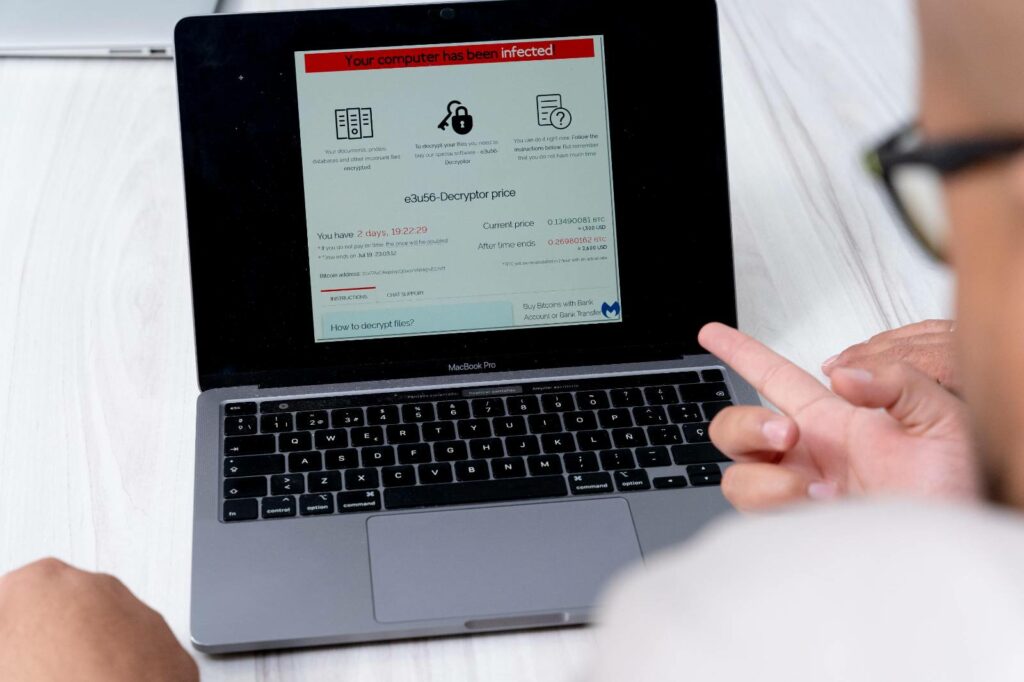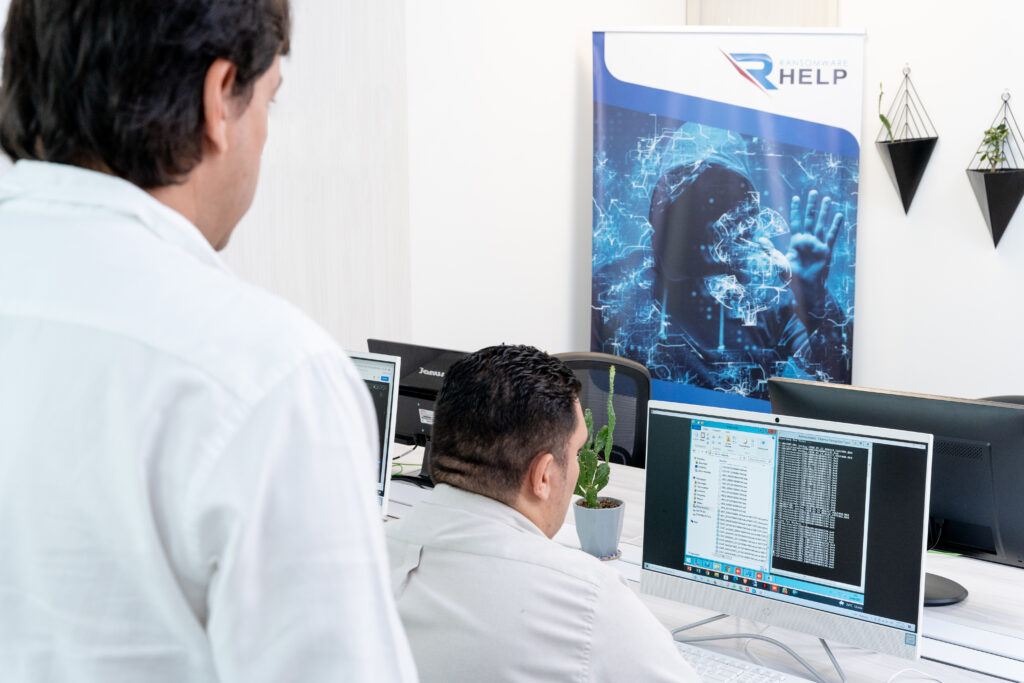With the new HelpRansomware guide, you will learn what malware is and how it spreads. Find out which is the most dangerous and what damages it can cause.

Fast & Guaranteed Recovery
HelpRansomware provides a 100% guaranteed ransomware removal and data recovery service, with 24/7 worldwide assistance.
What is malware?
Malware is malicious software installed on someone else’s computer, without the consent or knowledge of the owner, to carry out a harmful action.
Ransomware is currently the most active malware.
NIST defines malware as follows:
“Software or firmware intended to perform an unauthorized process that will have adverse impact on the confidentiality, integrity, or availability of an information system. A virus, worm, Trojan horse, or other code-based entity that infects a host. Spyware and some forms of adware are also examples of malicious code.”
What are the types of malware?
There are several types of malware, many of them are common and well-known:
- Ransomware: it is undoubtedly the most dangerous and most talked-about type of malware.
The hackers encrypt the data and ask for a cheap amount to release it.
Currently, they demand it in bitcoins due to the difficulty of tracking operations.
- Adware: its main objective is to saturate the user’s computer with advertising.
- Spyware: its function is to collect all the information of the user or company without permission.
It is installed on the computer, by itself or through an application, in a hidden way.
Spyware leaves no trace, and the user is oblivious to the entire process while working on the computer.
This type of virus analyzes all the data and actions carried out on the computer: installed applications, history, hard disk content, etc.
- Trojan: this type of malware “dresses” itself as a legitimate file to run on the computer.
It takes advantage of the vulnerability of the computer and steals information without the user noticing.
- Computer virus: to run the computer virus is necessary the user intervention.
Once installed, it infects all the files on the computer and seriously damages the system.
Sometimes it can show up in a Windows .exe file, but with the name of other applications to deceive the user.
- Computer worm: it has a similar purpose to the computer virus, but it does not need to be executed by the user.
It uses the contact list to infect them through copies.
It isn’t easy to detect because it does not alter the operation of the device.
Its presence is revealed, on the one hand, by the slowness of the applications. On the other hand, the sending of messages via email supplanting the identity of the user.

Fast & Guaranteed Recovery
HelpRansomware provides a 100% guaranteed ransomware removal and data recovery service, with 24/7 worldwide assistance.
Which malware is more dangerous?
Ransomware can be classified as the most dangerous and common malware today.
It is a type of cryptographic malware used for cyber extortion.
It keeps the files encrypted, through encryption, while demanding payment in exchange for the key.
The ransomware attack has evolved to target businesses and organizations.
How does malware spread?
Following, we analyze the most common methods in the spread of malware.
- Phishing: emails include attachments or links that direct the user to malware.
Through this technique, the hacker wants to access the personal data of users.
How to tell that an email is spam? The best way is to read the text carefully, and thus, indeed, you will discover that you are facing a scam.
The hacker can act suspiciously, requesting personal information or sending the email from a fake domain.
- Fraudulent web pages: cybercriminals try to copy the web domain of well-known brands for users to access.
Finally, this link will download malicious malware on the device.
USB memory: external storage devices can also be malware propagators, connecting the USB itself to an infected computer.
The best solution is to scan the USB device before working with it.
Immediate Ransomware Help
Don’t let ransomware hold your business hostage. Our experts are ready to recover your data and secure your systems.
- Adware: many web pages are full of ads to generate income.
But sometimes, they have malware, which can run on a user’s computer.
To avoid adware, you can use an adblocker or not go to these types of web pages at all.
- Legitimate software: cybercriminals sometimes use legitimate software to attack users who download it.
The malware is included directly in the application, and Internet users open it not thinking it is hidden in safe software and with a good reputation.
- Torrenting and P2P file sharing: Free downloading of film and music files has always spread malware.
Computer criminals include malicious code to contaminate users’ computers.
- Fake apps: mobile apps try to mislead their legitimacy so that users download them on their devices.
The best way to discover fake apps is by reading the app reviews and trusting the official developers.
Why do cybercriminals use malware?
As we have seen, there are several types of malware, but they all have identity theft and personal data theft in common.
Why do cybercriminals use malware?
They try to trick victims into providing their details, such as credit cards or other financial information.
With ransomware, the cybercriminal demands an amount of money in exchange for recovering the encrypted files.
Likewise, it can extort the user by publishing the information on the Deep Web or Dark Web.
Malware attacks have grown exponentially over the years.
We can visualize its increase, in the following infographic, with data from the AV-TEST Institute.

The figures refer to September 21, 2021, but the institution updates them periodically.
Every day it registers more than 450,000 new malware and potentially unwanted applications.
As of September 2021, the total amount of malware was 1,270.10 million.
This number is double that registered in 2016 (597.49 million).
Who creates the malware?
Behind the creation of malware are thieves, scammers, blackmailers, or cybercriminals.
Kaspersky makes the following explanation on his website about the origin of the malware:
“While the overwhelming majority of malicious programs are designed to make money illegally, the motives behind creating malware can range widely from pranks and activism, to cyber theft, espionage, and other serious crimes.”
So even if the malware startup was intended for pranks or highlighting the name as a cybercriminal, today, the goal is economic.
What are the damages that malware can cause?
The damage that malware can cause depends on the recipient, the type, and the data’s nature.
The first thing we must know is the type of recipient:
- Private: the infection affects the user’s data, primarily financial and banking information.
- Company: the virus attacks corporate information, which affects customer documents and endangers the company’s reputation.
Any company, large or small, is a target of cybercriminals.
In both cases, HelpRansomware is the solution for ransomware attacks.
It has the most outstanding cybersecurity services on the market.

Fast & Guaranteed Recovery
HelpRansomware provides a 100% guaranteed ransomware removal and data recovery service, with 24/7 worldwide assistance.
How do I know that malicious software infected me?
Different consequences can indicate that a device has been infected with malicious software:
- The computer can be locked, turned off, and even not turned on again.
- Programs are blocked or uninstalled; others get installed autonomously.
- Device performance is slower.
- The user encounters unwanted content when browsing the Internet, such as pop-ups or redirects to other websites.
How do I know if I have a virus or malware on my iPhone?
While Android is more prone to concentrating viruses, protection is what characterizes iOS.
The most common viruses that mobile devices receive are Trojans, adware, or spyware.
Generally, the permission system paralyzes the entry of a virus to iOS.
If the iPhone intercepts more permissions than usual, it alerts the user of unusual behavior.
The most dangerous case known in the iPhone is the entry of spam through the calendar app.
The user enters a website, accepts a message, and the calendar gets filled with events that the user did not create.
This is not considered a virus but an annoying action for the owner of the mobile.
How to undo this action on iOS?
- Open iPhone settings;
- Access ‘Calendar’;
- Click on “Accounts”;
- Click on “Subscribed calendars”;
- Delete account.
Likewise, the user can follow the following tips to increase the security of their device:
- Do not open suspicious links in emails and messages from unofficial sources.
- Enter a manual password, in addition to Touch ID and Face ID.
- Avoid connecting to unknown or unprotected Wi-Fi networks.
How do I remove malware?
Is it possible to remove malware? The answer is simple: it depends on the type of malware and the removal process you follow.
For example, in the case of ransomware, the hacker will ask you for money in exchange for restoring the encrypted files.
Here, the first thing to know is that you should never pay the hacker.
And, as a second step, contact a specialized company, such as HelpRansomware, to open encrypted files.

Immediate Ransomware Help
Don’t let ransomware hold your business hostage. Our experts are ready to recover your data and secure your systems.
Remove malware with antivirus
We can eliminate malware through an antivirus, also free.
Keep in mind that if you download an antivirus, you must do it from an official page.
The antivirus will analyze the computer and detect the number of viruses, computer worms, Trojans, etc.
Next, it will clean the infected files on the computer.
Antivirus does not remove malware
There is a possibility that the antivirus will not remove the malware because it damages the operating system.
One of the alternatives is to isolate the infected file and treat it when the antivirus is updated or with the application of a more powerful one.
Malware prevents access to the operating system
The aggressiveness of malware can prevent access to the operating system.
Therefore, the antivirus cannot be started.
The best way to access the computer is to start Windows in safe mode.
As a second option, you can log in remotely and perform a system restore.
Can Windows Defender remove malware?
Microsoft Defender is a software used to record threats in the operating system and protect it.
The antivirus should be by default on the computer; it can be downloaded from the official website if it is not there.
If you have to perform a computer scan, carry out the following steps:
- Click on ‘Start’;
- Click on ‘Settings’;
- Press ‘Update and security;

- Click on ‘Windows Security’;
- One Click on ‘Protection against viruses and threats’;

- Click on ‘Exam options’;
Likewise, Windows Defender warns you also of the possible threat of ransomware;

- Click on “Microsoft Defender Analysis Offline”.
If it is ransomware, contact a specialized team, such as HelpRansomware.
How do I get rid of malware for free?
It all depends on the type of malware you face because if it is less aggressive, you can solve it with a free antivirus.
In the case of ransomware, you will have to put yourself in the hands of a specialized team.
HelpRansomware continues to grow to tackle all types of ransomware, robustly, efficiently, and privately.
The company is fully dedicated to cybersecurity. Every resource it incorporates is to achieve its goal: to keep systems and data safe for people worldwide.
Conclusions
Through this guide, we have learned what malware is and how it spreads. You have discovered which is the most dangerous and what damage it can cause.
From this article, we can draw the following conclusions:
- Malware is malicious software installed on someone else’s computer, without the owner’s consent, to carry out a harmful action.
- There are different types of malware: ransomware, adware, spyware, Trojan horse, computer virus, and computer worm.
- Malware spreads in different ways like phishing, scam websites, adware, rogue apps, etc.
The most dangerous malware is ransomware, which uses cryptography to extort money from its victims.
HelpRansomware recovers files from any ransomware attack safely and quickly.

Fast & Guaranteed Recovery
HelpRansomware provides a 100% guaranteed ransomware removal and data recovery service, with 24/7 worldwide assistance.




